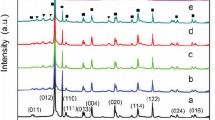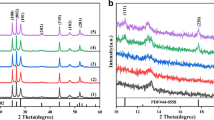Abstract
The utilization of photocatalytic enzyme-coupled systems is considered a promising solution to the solar energy conversion challenge, but it is hampered by its low cofactor regeneration efficiency. Herein, a biomimetic catalytic system was designed inspired by photosynthesis for cofactor regeneration and CO2 reduction. The Rh complexes were anchored in the core of metal-organic framework UiO67 and chitosan (CS) on the UiO67@Rh surface skillfully helped the in situ growth of CdS. In this core-shell nanoreactor, UiO67@Rh accepted the electrons produced by CdS for cofactor regeneration. CS acted as a bifunctional bio-scaffold to attach CdS and prevent CdS photocorrosion. Besides, CS spatially separated Rh complexes and CdS, preventing deactivation of Rh complexes by CdS and leakage of Rh complexes. Surprisingly, CS improved the photocatalytic activity and photostability of CdS, while other biomacromolecules did not have this function. The photocatalyst regeneration NADH cooperated with formate dehydrogenase (FDH) for CO2 reduction. The results showed that 0.72 mM formic acid was produced in 5 h (TOF = 0.14 mmol/mg/h), which was triple as much as in the system of UiO67@Rh@CdS and FDH. This cyclic process could be repeated up to 10 time cycles, where long-term stability of the system was observed and the active state of the enzymes was preserved. This study demonstrated a new and promising organometallic photocatalyst-based artificial cofactor regeneration system, paving the path for further research into the bespoke synthesis of fine chemicals and solar fuels from CO2 utilizing solar energy.
Graphical abstract
CdS nanoparticles compositing with chitosan and metal-organic frameworks for cofactor regeneration and CO2 reduction







Similar content being viewed by others
Data availability
The authors confirm that the data supporting the findings of this study are available within the article and Supplementary materials.
References
Kumar A, Daw P, Milstein D (2022) Homogeneous catalysis for sustainable energy: hydrogen and methanol economies, fuels from biomass, and related topics. Chem Rev 122(1):385–441. https://doi.org/10.1021/acs.chemrev.1c00412
Dong Z, Wang Y, Yang Q, Li D, Wu P (2023) Enhancing the compatibility of the amyloid-dye hybrid nanostructure for improved photo-biocatalysis. J Energy Chem 78:430–437. https://doi.org/10.1016/j.jechem.2022.12.040
Lee SH, Choi DS, Kuk SK, Park CB (2018) Photobiocatalysis: activating redox enzymes by direct or indirect transfer of photoinduced electrons. Angew Chem Int Ed 57(27):7958–7985. https://doi.org/10.1002/anie.201710070
Tan X, Nielsen J (2022) The Integration of bio-catalysis and electrocatalysis to produce fuels and chemicals from carbon dioxide. Chem Soc Rev 51(11):4763–4785. https://doi.org/10.1039/d2cs00309k
Sundaram S, Diehl C, Cortina NS, Bamberger J, Paczia N, Erb TJ (2021) A modular in vitro platform for the production of terpenes and polyketides from CO2. Angew Chem Int Ed 60(30):16420–16425. https://doi.org/10.1002/anie.202102333
Li L, Ozden A, Guo S, Garci AdAFP, Wang C, Zhang M, Zhang J, Jiang H, Wang W, Dong H, Sinton D et al (2021) Stable, active CO2 reduction to formate via redox-modulated stabilization of active sites. Nat Commun 12(1):5223. https://doi.org/10.1038/s41467-021-25573-9
Ma Z, Legrand U, Pahija E, Tavares JR, Boffito DC (2021) From CO2 to formic acid fuel cells. Ind Eng Chem Res 60(2):803–815. https://doi.org/10.1021/acs.iecr.0c04711
Miller M, Robinson WE, Oliveira AR, Heidary N, Kornienko N, Warnan J, Pereira IAC, Reisner E (2019) Interfacing formate dehydrogenase with metal oxides for the reversible electrocatalysis and solar-driven reduction of carbon dioxide. Angew Chem Int Ed 58(14):4601–4605. https://doi.org/10.1002/anie.201814419
Nowak C, Pick A, Lommes P, Sieber V (2017) Enzymatic reduction of nicotinamide biomimetic cofactors using an engineered glucose dehydrogenase: providing a regeneration system for artificial cofactors. ACS Catal 7(8):5202–5208. https://doi.org/10.1021/acscatal.7b00721
Luan P, Li Y, Huang C, Dong L, Ma T, Liu J, Gao J, Liu Y, Jiang Y (2022) Design of de novo three-enzyme nanoreactors for stereodivergent synthesis of α-substituted cyclohexanols. ACS Catal 12(13):7550–7558. https://doi.org/10.1021/acscatal.2c02136
Yang B, Li S, Mu W, Wang Z, Han X (2022) Light-harvesting artificial cells containing cyanobacteria for CO2 fixation and further metabolism mimicking. Small 19:2201305. https://doi.org/10.1002/smll.202201305
Kuk SK, Singh RK, Nam DH, Singh R, Lee JK, Park CB (2017) Photoelectrochemical reduction of carbon dioxide to methanol through a highly efficient enzyme cascade. Angew Chem Int Ed 56(14):3827–3832. https://doi.org/10.1002/anie.201611379
Megarity CF, Siritanaratkul B, Heath RS, Wan L, Morello G, FitzPatrick SR, Booth RL, Sills AJ, Robertson AW, Warner JH, Turner NJ et al (2019) Electrocatalytic volleyball: rapid nanoconfined nicotinamide cycling for organic synthesis in electrode pores. Angew Chem Int Ed 58(15):4948–4952. https://doi.org/10.1002/anie.201814370
Wang H, Chen J, Dong Q, Jia X, Li D, Wang J, Wang E (2022) Cadmium sulfide as bifunctional mimics of NADH oxidase and cytochrome c reductase takes effect at physiological pH. Nano Res 15(6):5256–5261. https://doi.org/10.1007/s12274-022-4150-8
Cheng Y, Shi J, Wu Y, Wang X, Sun Y, Cai Z, Chen Y, Jiang Z (2021) Intensifying electron utilization by surface-anchored Rh complex for enhanced nicotinamide cofactor regeneration and photoenzymatic CO2 reduction. Research 2021:1–11. https://doi.org/10.34133/2021/8175709
Lee JM, Jin HB, Kim IY, Jo YK, Hwang JW, Wang KK, Kim MG, Kim YR, Hwang SJ (2015) A crucial role of Rh substituent ion in photoinduced internal electron transfer and enhanced photocatalytic activity of CdS-Ti(5.2-x)/6Rhx/2O2 nanohybrids. Small 11(41):5771–5780. https://doi.org/10.1002/smll.201501806
Cheng L, Xiang Q, Liao Y, Zhang H (2018) CdS-based photocatalysts. Energy Environ Sci 11(6):1362–1391. https://doi.org/10.1039/c7ee03640j
Nam DH, Lee SH, Park CB (2010) CdTe, CdSe, and CdS nanocrystals for highly efficient regeneration of nicotinamide cofactor under visible light. Small 6(8):922–926. https://doi.org/10.1002/smll.201000077
Xu HQ, Yang S, Ma X, Huang J, Jiang HL (2018) Unveiling charge-separation dynamics in CdS/metal-organic framework composites for enhanced photocatalysis. ACS Catal 8(12):11615–11621. https://doi.org/10.1021/acscatal.8b03233
Han HX, Tian LJ, Liu DF, Yu HQ, Sheng GP, Xiong Y (2022) Reversing electron transfer chain for light-driven hydrogen production in biotic-abiotic hybrid systems. J Am Chem Soc 144(14):6434–6441. https://doi.org/10.1021/jacs.2c00934
Boecker M, Micheel M, Mengele AK, Neumann C, Herberger T, Marchesi D’Alvise T, Liu B, Undisz A, Rau S, Turchanin A, Synatschke CV et al (2021) Rhodium-complex-functionalized and polydopamine-coated CdSe@CdS nanorods for photocatalytic NAD+ reduction. ACS Appl Nano Mater 4(12):12913–12919. https://doi.org/10.1021/acsanm.1c02994
Jiang R, Zhu H, Yao J, Fu Y, Guan Y (2012) Chitosan hydrogel films as a template for mild biosynthesis of CdS quantum dots with highly efficient photocatalytic activity. Appl Surf Sci 258(8):3513–3518. https://doi.org/10.1016/j.apsusc.2011.11.105
Zhang Y, Zhou W, Jia L, Tan X, Chen Y, Huang Q, Shao B, Yu T (2020) Visible light driven hydrogen evolution using external and confined CdS: effect of chitosan on carriers separation. Appl Catal B Environ 277:119152. https://doi.org/10.1016/j.apcatb.2020.119152
Zhang Y, Wei B, Liang H (2023) Rhodium-based MOF-on-MOF difunctional core-shell nanoreactor for NAD(P)H regeneration and enzyme directed immobilization. ACS Appl Mater Interfaces 15(2):3442–3454. https://doi.org/10.1021/acsami.2c18440
Pitman CL, Finster ONL, Miller AJM (2016) Cyclopentadiene-mediated hydride transfer from rhodium complexes. Chem Commun 52(58):9105–9108. https://doi.org/10.1039/C6CC00575F
Lo HC, Buriez O, Kerr JB, Fish RH (1999) Regioselective reduction of NAD+ models with [Cp*Rh(bpy)H]+: structure-activity relationships and mechanistic aspects in the formation of the 1,4-NADH derivatives. Angew Chem Int Ed 38:1429–1432. https://doi.org/10.1002/(SICI)1521-3773(19990517)38:10%3c1429::AID-ANIE1429%3e3.0.CO;2-Q
Benseghir Y, Lemarchand A, Duguet M, Mialane P, Gomez-Mingot M, Roch-Marchal C, Pino T, Ha-Thi MH, Haouas M, Fontecave M, Dolbecq A et al (2020) Co-immobilization of a Rh catalyst and a keggin polyoxometalate in the UiO-67 Zr-based metal-organic framework: in depth structural characterization and photocatalytic properties for CO2 reduction. J Am Chem Soc 142(20):9428–9438. https://doi.org/10.1021/jacs.0c02425
Alqarni DS, Marshall M, Turner DR, Gengenbach TR, Chaffee AL (2021) Metal nanoparticles formed by thermal transformation of M-MIL140C (M=In, Rh, Pd). Micropor Mesopor Mat 324:111264.https://doi.org/10.1016/j.micromeso.2021.111264
Chen J, Ouyang J, Chen W, Zheng Z, Yang Z, Liu Z, Zhou L (2022) Fabrication and adsorption mechanism of chitosan/Zr-MOF (UiO-66) composite foams for efficient removal of ketoprofen from aqueous solution. Chem Eng J 431:134045. https://doi.org/10.1016/j.cej.2021.134045
Jia X, Zhang B, Chen C, Fu X, Huang Q (2021) Immobilization of chitosan grafted carboxylic Zr-MOF to porous starch for sulfanilamide adsorption. Carbohydr Polym 253:117305. https://doi.org/10.1016/j.carbpol.2020.117305
Harish R, Nisha KD, Prabakaran S, Sridevi B, Harish S, Navaneethan M, Ponnusamy S, Hayakawa Y, Vinniee C, Ganesh MR (2020) Cytotoxicity assessment of chitosan coated CdS nanoparticles for bio-imaging applications. Appl Surf Sci 499:143817. https://doi.org/10.1016/j.apsusc.2019.143817
Wu X, Wang S, Fang J, Chen H, Liu H, Li R (2022) Enhanced photocatalytic efficiency in visible-light-induced NADH regeneration by intramolecular electron transfer. ACS Appl Mater Interfaces 14(34):38895–38904. https://doi.org/10.1021/acsami.2c11174
Biswal Scheiner HS (2015) Hydrogen bonds involving sulfur: new insights from ab initio calculations and gas phase laser spectroscopy. Noncovalent Forces 19:15–45. https://doi.org/10.1007/978-3-319-14163-3_2
Zhang L, Etienne M, Vilà N, Le TXH, Kohring GW, Walcarius A (2018) Electrocatalytic biosynthesis using a bucky paper functionalized by [Cp*Rh(bpy)Cl]+ and a renewable enzymatic layer. ChemCatChem 10(18):4067–4073. https://doi.org/10.1002/cctc.201800681
Wei RB, Huang ZL, Gu GH, Wang Z, Zeng L, Chen Y, Liu ZQ (2018) Dual-cocatalysts decorated rimous CdS spheres advancing highly-efficient visible-light photocatalytic hydrogen production. Appl Catal B Environ 231:101–107. https://doi.org/10.1016/j.apcatb.2018.03.014
Ruan M, Guo D, Jia Q (2021) A uniformly decorated and photostable polydopamine-organic semiconductor to boost the photoelectrochemical water splitting performance of CdS photoanodes. Dalton Trans 50(5):1913–1922. https://doi.org/10.1039/d0dt04056h
Hu Y, Hao X, Cui Z, Zhou J, Chu S, Wang Y, Zou Z (2020) Enhanced photocarrier separation in conjugated polymer engineered CdS for direct Z-scheme photocatalytic hydrogen evolution. Appl Catal B Environ 260:118131. https://doi.org/10.1016/j.apcatb.2019.118131
Yadav RK, Baeg JO, Oh GH, Park NJ, Kong KJ, Kim J, Hwang DW, Biswas SK (2012) A photocatalyst-enzyme coupled artificial photosynthesis system for solar energy in production of formic acid from CO2. J Am Chem Soc 134(28):11455–11461. https://doi.org/10.1021/ja3009902
Yue X, Yi S, Wang R, Zhang Z, Qiu S (2017) Cobalt phosphide modified titanium oxide nanophotocatalysts with significantly enhanced photocatalytic hydrogen evolution from water splitting. Small 13(14):1603301. https://doi.org/10.1002/smll.201603301
Burnett RW, Underwood AL (1968) A dimer of diphosphopyridine nucleotide. Biochemistry 7(10):3328–3333. https://doi.org/10.1021/bi00850a003
Gȩbicki J, Marcinek A, Zielonka J (2004) Transient species in the stepwise interconversion of NADH and NAD+. Acc Chem Res 37(6):379–386. https://doi.org/10.1021/ar030171j
Zhang S, Shi J, Chen Y, Huo Q, Li W, Wu Y, Sun Y, Zhang Y, Wang X, Jiang Z (2020) Unraveling and manipulating of NADH oxidation by photogenerated holes. ACS Catal 10(9):4967–4972. https://doi.org/10.1021/acscatal.0c00471
Ji X, Liu C, Wang J, Su Z, Ma G, Zhang S (2017) Integration of functionalized two-dimensional TaS2 nanosheets and an electron mediator for more efficient biocatalyzed artificial photosynthesis. J Mater Chem A 5(11):5511–5522. https://doi.org/10.1039/c7ta00002b
Acknowledgements
Thanks to Zhang Xu’s research group for our support of photocatalytic instruments.
Funding
This study was funded by the National Key Research and Development Program of China (2021YFC2102800) and the National Natural Science Foundation of China (22078014).
Author information
Authors and Affiliations
Contributions
YZ: experimental design and planning, performing the experiments, writing the initial draft and revised manuscript. HL: ideas, oversight and leadership responsibility for the research activity planning and execution, revised the initial draft and funding acquisition.
Corresponding author
Ethics declarations
Conflict of interest
The authors declare no competing interests.
Additional information
Publisher's Note
Springer Nature remains neutral with regard to jurisdictional claims in published maps and institutional affiliations.
Supplementary Information
Below is the link to the electronic supplementary material.
Rights and permissions
Springer Nature or its licensor (e.g. a society or other partner) holds exclusive rights to this article under a publishing agreement with the author(s) or other rightsholder(s); author self-archiving of the accepted manuscript version of this article is solely governed by the terms of such publishing agreement and applicable law.
About this article
Cite this article
Zhang, Y., Liang, H. Cadmium sulfide nanoparticles compositing with chitosan and metal-organic framework: Enhanced photostability and increased carbon dioxide reduction. Adv Compos Hybrid Mater 7, 21 (2024). https://doi.org/10.1007/s42114-024-00837-2
Received:
Revised:
Accepted:
Published:
DOI: https://doi.org/10.1007/s42114-024-00837-2




